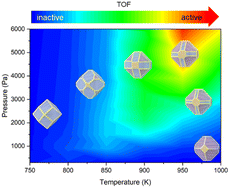Identifying the morphology of Pt nanoparticles for the optimal catalytic activity towards CO oxidation†
Abstract
The morphology of nanoparticles (NPs) is crucial for determining their catalytic performance. The dramatic changes in the morphology of metal NPs during reactions observed in many in situ experiments pose great challenges for the identification of the geometry for optimal catalytic activities, which arouses the controversial understanding of the reaction mechanism. In this work, taking CO oxidation as a model reaction, we coupled a multiscale structure reconstruction model with kinetic Monte Carlo simulations to study the catalytic performance of the Pt NPs with changing morphology and reaction conditions. Through the quantitative analysis of contour plots for turnover frequencies, we show that the NPs with more well-coordinated sites exhibit optimal activity under CO-rich conditions at higher temperatures, while the reactivity of NPs with more low-coordination sites is optimal under O2-rich conditions at lower temperatures. Further analysis indicates that the competitive adsorption of CO and O2 plays the key role, in which the structure with optimal activity has a closer CO and O coverage. This work not only reconciles the controversy of the active geometry in the experiments, but offers an efficient method to guide the rational design of high-performance catalysts.



 Please wait while we load your content...
Please wait while we load your content...